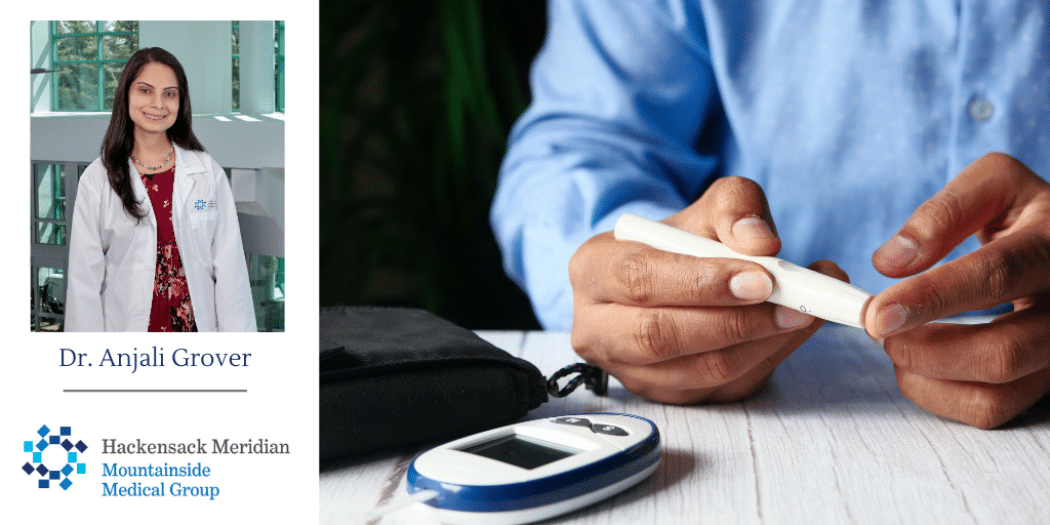More than 34.2 million Americans are living with diabetes. Despite the commonality of this disease, there are a lot of misconceptions about diabetes, its types, diagnosis and treatment. To get a better understanding of diabetes, we spoke with Mountainside Medical Group’s Anjali Grover, M.D.
“Diabetes can affect all parts of the body,” Dr. Grover said. “Because of the number of complications associated with diabetes, we divide them up into two categories, macrovascular (MACRO) complications and microvascular (MICRO) complications. MACRO complications include risk of stroke, heart disease, heart attack, kidney complications and obesity. MICRO complications include eye disease, or retinopathy and nerve complications, or neuropathy. Risk of COVID-19 is also increased at this time.”
Many people are familiar with the terms Type 1 diabetes and Type 2 diabetes, but fewer people understand what factors differentiate these two types of diabetes.
“Diabetes starts with the hormone insulin, which should be made in our pancreas,” Dr. Grover said. “Insulin’s job is to move glucose from the bloodstream to your cells where it is used as fuel to energize the cells to do its job. In Type 1 diabetes, an autoimmune process occurs where the body attacks the part of the pancreas that makes insulin hormone. So, we produce very little, or no insulin. The treatment is strictly insulin. In Type 2 diabetes, our body makes insulin, but there is insulin resistance. The rest of the body doesn’t always listen to the insulin. So, the pancreas needs to make more insulin just to do the job.”
Dietary changes are often synonymous with a diabetes diagnosis, but Dr. Grover’s suggestions for a diabetic diet may surprise you.
“Eat breakfast like a king, lunch like a prince and dinner like a pauper,” Dr. Grover said. “This means eat a good breakfast and lunch, and dinner should be your lightest meal because we are least active at that time of the day and our metabolism is the slowest. Visualize a 9-inch plate. Half of your plate should be non-starchy vegetables, a quarter of the plate should be protein and the remaining quarter should be filled with starchy vegetables. You don’t have to eliminate carbohydrates, as they are a source of energy for your body, but avoid processed, white carbohydrates that have a high glycemic index, those will spike your blood sugar. To really break it down, individuals should be consuming about 30-45 grams of carbs at breakfast, an additional 30-45 grams of carbs at lunch and 20-30 grams of carbs at dinner. You can also have a snack during the day with 15 grams of carbs. Watch your carbs and know your carbs. If you’re trying to prevent diabetes, do some form of activity 20-30 minutes a day, five days a week. Consistency is key, so find something that you enjoy, whether that’s walking, sports, the gym or even dancing.”
A less common type of diabetes is referred to as gestational diabetes.
“Gestational diabetes occurs when there are blood sugar irregularities, including elevation, during pregnancy, often detected in the second trimester,” Dr. Grover said. “This happens due to a hormone made by the placenta which causes blood sugar levels to rise. Women that are at risk include those with a family history of diabetes, a personal history of prediabetes or obesity or certain hormonal disorders such as polycystic ovarian syndrome.”
Regardless of the type, Dr. Grover warns diabetes puts individuals at a higher risk for COVID-19.
“Diabetes itself within the body, when it’s not controlled, it creates a lot of inflammation in different organs and that alone increases your risk for contracting COVID-19,” Dr. Grover said. “I would highly recommend the vaccine to anyone who has a diagnosis of diabetes or obesity.”
To schedule an appointment with Dr. Grover, click here or call 973-798-4777.

